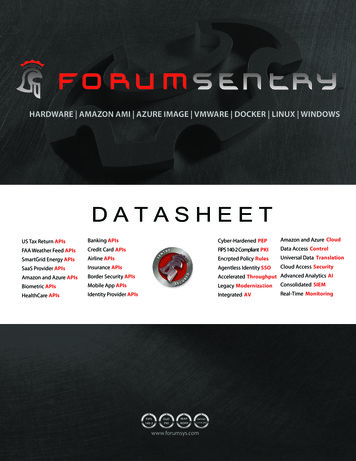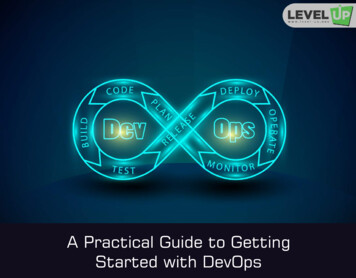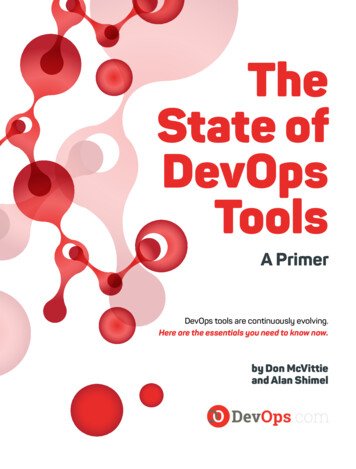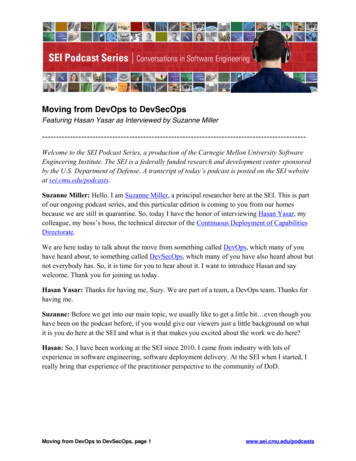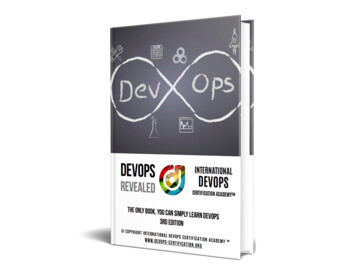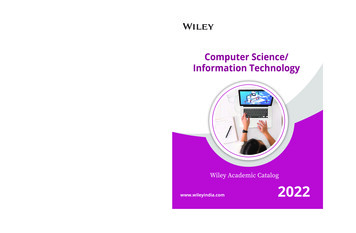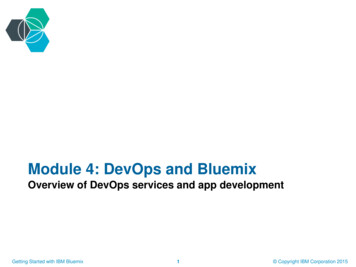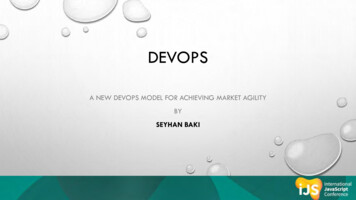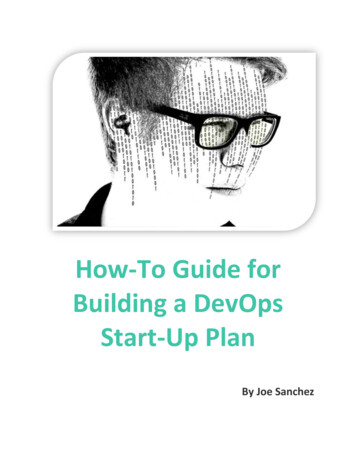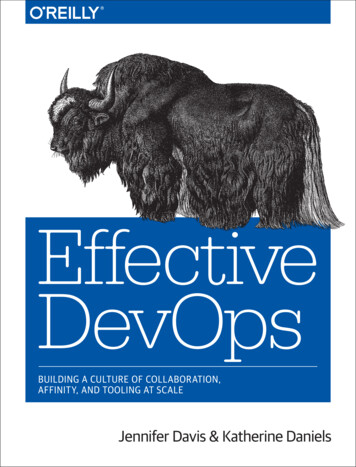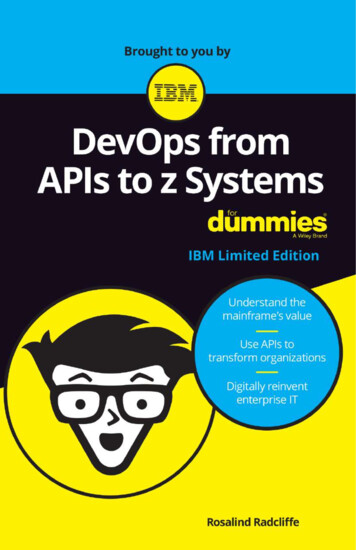
Transcription
DevOps fromAPIs to z SystemsIBM Limited Editionby Rosalind RadcliffeThese materials are 2017 John Wiley & Sons, Inc. Any dissemination, distribution, or unauthorized use is strictly prohibited.
DevOps from APIs to z Systems For Dummies , IBM Limited EditionPublished byJohn Wiley & Sons, Inc.111 River St.Hoboken, NJ 07030-5774www.wiley.comCopyright 2017 by John Wiley & Sons, Inc.No part of this publication may be reproduced, stored in a retrieval system or transmitted in any formor by any means, electronic, mechanical, photocopying, recording, scanning or otherwise, except aspermitted under Sections 107 or 108 of the 1976 United States Copyright Act, without the prior writtenpermission of the Publisher. Requests to the Publisher for permission should be addressed to thePermissions Department, John Wiley & Sons, Inc., 111 River Street, Hoboken, NJ 07030, (201) 748-6011,fax (201) 748-6008, or online at http://www.wiley.com/go/permissions.Trademarks: Wiley, For Dummies, the Dummies Man logo, The Dummies Way, Dummies.com, MakingEverything Easier, and related trade dress are trademarks or registered trademarks of John Wiley & Sons,Inc. and/or its affiliates in the United States and other countries, and may not be used without writtenpermission. IBM and the IBM logo are registered trademarks of International Business MachinesCorporation. All other trademarks are the property of their respective owners. John Wiley & Sons, Inc.,is not associated with any product or vendor mentioned in this book.LIMIT OF LIABILITY/DISCLAIMER OF WARRANTY: THE PUBLISHER AND THE AUTHOR MAKE NOREPRESENTATIONS OR WARRANTIES WITH RESPECT TO THE ACCURACY OR COMPLETENESS OF THECONTENTS OF THIS WORK AND SPECIFICALLY DISCLAIM ALL WARRANTIES, INCLUDING WITHOUTLIMITATION WARRANTIES OF FITNESS FOR A PARTICULAR PURPOSE. NO WARRANTY MAY BE CREATEDOR EXTENDED BY SALES OR PROMOTIONAL MATERIALS. THE ADVICE AND STRATEGIES CONTAINEDHEREIN MAY NOT BE SUITABLE FOR EVERY SITUATION. THIS WORK IS SOLD WITH THE UNDERSTANDINGTHAT THE PUBLISHER IS NOT ENGAGED IN RENDERING LEGAL, ACCOUNTING, OR OTHER PROFESSIONALSERVICES. IF PROFESSIONAL ASSISTANCE IS REQUIRED, THE SERVICES OF A COMPETENT PROFESSIONALPERSON SHOULD BE SOUGHT. NEITHER THE PUBLISHER NOR THE AUTHOR SHALL BE LIABLE FORDAMAGES ARISING HEREFROM. THE FACT THAT AN ORGANIZATION OR WEBSITE IS REFERRED TO INTHIS WORK AS A CITATION AND/OR A POTENTIAL SOURCE OF FURTHER INFORMATION DOES NOT MEANTHAT THE AUTHOR OR THE PUBLISHER ENDORSES THE INFORMATION THE ORGANIZATION OR WEBSITEMAY PROVIDE OR RECOMMENDATIONS IT MAY MAKE. FURTHER, READERS SHOULD BE AWARE THATINTERNET WEBSITES LISTED IN THIS WORK MAY HAVE CHANGED OR DISAPPEARED BETWEEN WHENTHIS WORK WAS WRITTEN AND WHEN IT IS READ.For general information on our other products and services, or how to create a custom For Dummies bookfor your business or organization, please contact our Business Development Department in the U.S. at877-409-4177, contact info@dummies.biz, or visit www.wiley.com/go/custompub. For information aboutlicensing the For Dummies brand for products or services, contact BrandedRights&Licenses@Wiley.com.ISBN: 978-1-119-41023-2 (pbk); ISBN: 978-1-119-41024-9 (ebk)Manufactured in the United States of America10 9 8 7 6 5 4 3 2 1Publisher’s AcknowledgmentsSome of the people who helped bring this book to market include thefollowing:Project Editor: Carrie A. BurchfieldEditorial Manager: Rev MengleAcquisitions Editor: Steve HayesBusiness DevelopmentRepresentative: Sue BlessingProduction Editor: Magesh ElangovanThese materials are 2017 John Wiley & Sons, Inc. Any dissemination, distribution, or unauthorized use is strictly prohibited.
Table of ContentsINTRODUCTION . 1About This Book . 2Icons Used in This Book. 2Beyond the Book . 3CHAPTER 1:nderstandin t e alue of t e Mainframe . 5Defining Mainframes and Their Importance . 6Calculating the Value of the Mainframe . 7Placing Mainframe at the Heart of the Hybrid IT World . 9Hybrid infrastructure . 10Hybrid data . 10Hybrid applications . 10Integrating Systems of Engagement with Systemsof Record . 11Transforming Organizations to Service Providerswith APIs . 12CHAPTER 2:nderstandin t e ypical MainframeApplication Development allen es . 15Understanding Application Complexity . 16Measuring Risk in Changing Business CriticalApplications. 17System Availability. 18Manual Test Processes . 19Fragmentation of Skills and Tools . 19Siloed Teams . 20CHAPTER 3:DevOps and t e MainframeMission Possible . 21Defining DevOps? . 21Culture . 23Think . 24Code. 24Deliver . 27Manage. 27Learn. 28Why DevOps Is Critical for Mainframe Environments . 28Table of ContentsiiiThese materials are 2017 John Wiley & Sons, Inc. Any dissemination, distribution, or unauthorized use is strictly prohibited.
The Balancing Act: People, Processes, and Tools . 31People. 31Processes . 32Tools . 33What Problems Does DevOps Solve?. 34Improving Application Development with DevOps . 35CHAPTER 4:Loo in at DevOps Best Practicesfor z Systems . 37Adopting DevOps Best Practices for z Systems . 37Modern development practices and tools. 38Test environments . 40Common deployment . 43Improving Productivity and Optimizing Systems . 43Improving productivity . 43Optimizing systems . 45CHAPTER 5:Applyin Open Source ools toDevOps and z Systems. 47Open-Source Pipeline . 48Git. 48Build system . 50Pipeline orchestrator . 50Deployment system . 50Build artifact repository . 50Open Source and z Development . 51SCM for z/OS source . 51Build system . 52Pipeline orchestrator . 52Deployment system . 52Built artifact repository . 53CHAPTER 6:Buildin for t e Di ital Economy . 55Understanding How Mainframe Is at the Heart of the DigitalEconomy . 55Looking at Full Application Life Cycle Management. 58CHAPTER 7:Seein DevOps Success Storiesin the Enterprise. 61Development Modernization . 61Large financial organization . 62ivDevOps from APIs to z Systems For Dummies, IBM Limited EditionThese materials are 2017 John Wiley & Sons, Inc. Any dissemination, distribution, or unauthorized use is strictly prohibited.
Large financial organization in Europe . 63CICS development organization . 64Automated Testing and Deployment. 65Application Understanding . 66Seizing control of development . 67Unleashing progress. 67Full Practice Adoption . 68CHAPTER 8:Ma in a DevOps ransition . 71Getting Started with DevOps . 71Guiding You through a DevOps Transformation Process . 72Step 1: Pick the right set of applications . 73Step 2: Develop the vision . 73Step 3: Determine what’s holding you back . 74Step 4: Transition to DevOps . 74Step 5: Measure the ROI . 74Step 6: Repeat . 76CHAPTER 9:Understanding Where DevOpsan a e ou. 77How Cloud and DevOps Come Together in theEnterprise . 77The problem . 78APIs: A paradigm shift . 79Building the Next Generation Enterprise IT Skills . 82Fit for Purpose Platforms . 83Myth Busters for Mainframe DevOps . 84DevOps is for born-on-the-web companies . 84DevOps implies continuous deployment into production . 84DevOps and ITIL don’t go together . 85DevOps and separation of duties don’t mix . 85DevOps is only for small companies . 85DevOps is only about automated deployment . 86DevOps is all about improving cycle time . 86DevOps is a tool . 87Table of ContentsvThese materials are 2017 John Wiley & Sons, Inc. Any dissemination, distribution, or unauthorized use is strictly prohibited.
viDevOps from APIs to z Systems For Dummies, IBM Limited EditionThese materials are 2017 John Wiley & Sons, Inc. Any dissemination, distribution, or unauthorized use is strictly prohibited.
IntroductionDevOps is a way of doing business; it applies to all aspects ofan organization. DevOps brings Agile and Lean IT practicesto the entire organization to allow for quick reaction tobusiness demands. De O s a lies to all or ani ationsnew,born-on-the-web companies as well as traditional small andlarge businesses that have been around for many years.With the drive today toward an application programming interface (API) economy and the need to respond even more quicklyto business re uirements, com anies must chan e their internalpractices. This is why DevOps has become the de facto standardfor high-achieving businesses. The ability to respond quicklyto new ideas, e eriment with di erent ossible solutions, anddeli er e istin business with reater reliability and securityrequires this fundamental change.In some ways the term DevOps is misleadin , im lyin onlyDe elo ment and O erations are in ol ed, but really it s all othe organization from the business through the running system.Everyone in the organization must be responsible for delivery.The organizations that embrace this overall change have seen thegreatest value from the transformation.In lar e scale or ani ations this trans ormation can be harder,but it s more critical or ust those com anies. The number osilos is enerally reatly increased in lar e or ani ations, andremoving the silos is critical to DevOps. These large-scale organi ations ha e e istin systems that ro ide si nificant alue buthave been built up over years. These systems sometimes referredto as the systems of record have valuable business assets that needto be e osed to new business ossibilities and need to be able tobe updated rapidly. DevOps brings this ability to these systemsand improves the ability to integrate these systems with the newmobile interfaces or systems of engagement.DevOps is the cultural change to help achieve the value promiseo the API economy, a lyin to all or ani ations and all arts othe or ani ation. With De O s, com anies transition their olicies and procedures to support this new culture as well as bring inthe right tools to support this change.Introduction1These materials are 2017 John Wiley & Sons, Inc. Any dissemination, distribution, or unauthorized use is strictly prohibited.
About This BookDevOps from APIs to z Systems For Dummies, IBM Limited Edition, isdesi ned or e ecuti es, decision ma ers, and ractitioners whoare in organizations that have to deal with mainframe systemsor anyone who wants to learn more how DevOps can work withinlar e scale e istin or ani ations.This boo also hel s com anies with e istin de elo ment ando erations or ani ations that are se arated and siloed, including those that are outsourced. You also discover a little historybehind how these silos developed and how now is the perfect timeto transition to a DevOps culture.DevOps from APIs to z Systems For Dummies, IBM Limited Edition,contains some e am les o how other com anies ha e ainedbusiness value in their transitions to DevOps. DevOps is an ongoin ourney or com anies, and in this u dated edition, the e amples show the greater value that can be achieved by continuingwith the transformation and by truly building a DevOps culture.Icons Used in This BookYou find se eral icons in the mar ins o this boo . Here s whatthey mean.The Tip icon points out helpful information on various aspects ofDevOps.Anything with the Remember icon is something to keep in mindas you adopt DevOps.The Warnin icon alerts you to ossible side e ects and/or im lications of adopting DevOps.Technical Stuoes into s ecific details that may be more rele ant to a ractitioner than to an e ecuti e.2DevOps from APIs to z Systems For Dummies, IBM Limited EditionThese materials are 2017 John Wiley & Sons, Inc. Any dissemination, distribution, or unauthorized use is strictly prohibited.
Beyond the BookThis booro ides an introduction to De O s and how it fits inorganizations that have cross-platform environments includingmain rames. But these a es can hold only so much, so or morein ormation beyond what s co ered here, chec out the ollowing links:»»»»IBM Enterprise DevOps: http://ibm.biz/DevOps4zIBM DevOps for Enterprise Systems POV: http://ibm.biz/IBMDOESPOVBuilding an Enterprise API Strategy: https://ibm.biz/BdrjtHDevOps on z Systems eGuide: http://ibm.co/1QWTCDaIntroduction3These materials are 2017 John Wiley & Sons, Inc. Any dissemination, distribution, or unauthorized use is strictly prohibited.
4DevOps from APIs to z Systems For Dummies, IBM Limited EditionThese materials are 2017 John Wiley & Sons, Inc. Any dissemination, distribution, or unauthorized use is strictly prohibited.
IN THIS CHAPTER» De nin mainframes andimportanty t ey re» Seein t e mainframe s value» De nin t e mainframe s role in t eybrid Iorld» Discoverin o to inte rate systems ofen a ement it systems of record»Chaptersin APIs to transform or anizations1Understanding thealue of t e MainframeWhen you hear the word mainframe, many di erentthoughts may come to mind. To some, the mainframeis an old machine no longer in use. To others, mainframes are, by far, the most reliable computing solution available.There was a time when it was “common knowledge” that themainframe was dead. To paraphrase Mark Twain, news of themainframe’s demise was greatly exaggerated.Most consider the mainframe’s birth to coincide with the April 7,1964, announcement of the IBM System/360 line of computers.After more than 50 years of evolution and technological advances,the mainframe continues to run most of the world’s businesses.According to IBM market development and insights»»The mainframe is essential to 44 out of the top 50 worldwidebanks.70 percent of the United States’ largest retailers use zSystems.CHAPTER 1nderstandin t e alue of t e Mainframe5These materials are 2017 John Wiley & Sons, Inc. Any dissemination, distribution, or unauthorized use is strictly prohibited.
»»»10 out of 10 of the world’s largest insurers use themainframe.90 percent of the world’s largest airlines use z Systems.1.3 million CICS transactions are processed every second,every day. In comparison, there are 68,542 Google searchesevery second globally.In this chapter, I give you the background for the mainframe andhow it’s used today.De nin Mainframes andeir ImportanceLarge scale computing started out with built-for-purposemachines, tar eted to s ecific use cases, such as the business classmachines and the scientific class machines. This di ision o laboreven gave rise to two separate user groups, GUIDE and SHARE:GUIDE or the Business and SHARE or the Scientific. O er theyears, these groups merged as well. In the United States, SHAREcontinues to be the premier user group for enterprise organizations. There are equivalent groups all over the world.Some 53 years ago, on April 7, 1964, IBM introduced a new line ofgeneral-purpose computers to serve the needs of businesses, universities, governments, and, in fact, any organization that neededlarge-scale transaction performance. These computers and theirsuccessors became known as mainframes.A number of operating systems have been developed to run on themainframe hardware:»»6For ultra-high-speed transaction processing, there’s z/TPF orTransaction Processing Facility.z/VM is used to provide virtualization environments toallow other operating systems to share the mainframeplatform.DevOps from APIs to z Systems For Dummies, IBM Limited EditionThese materials are 2017 John Wiley & Sons, Inc. Any dissemination, distribution, or unauthorized use is strictly prohibited.
»»For more general purpose enterprise production workloads,there’s z/OS.The most recent addition is Linux for z Systems, completingthe Linux story across the server lines.These di erent o eratin systems ro ide di erent ca abilitiesfor organizations while taking advantage of the underlying reliability of the hardware.The current generation of the mainframe is the z Systems z13.Thecan rocess . billion transactions a daythe e ui alent of 100 cyber Mondays every day of the year. The z13 is themost modern mainframe hardware available, with a new processor desi n able to address TB o memory, with aster I/O and uto 141 processor units in one machine. A single footprint can runas many as 8,000 virtual servers.alculatin t e alue of t eMainframeThe mainframe was designed from the casters up to be the ideallat orm or traditional online transaction rocessin OLTP wor loads. Thewas s ecifically enhanced to handle the e losi egrowth that today’s mobile users are driving into the mainframe.The z13, with built-in encryption technology and the capability todo inline analytics, can be the basis for key business solutions suchas real-time analytics and in-transaction fraud detection.The z Systems machines provide this capability in the mostener y efficient machines. The a era e business class main rames uses about the same amount o ower as ust our itchenco ee ma ers, or less electricity than a clothes dryer. Whilesome ser er lines fill rooms and challen e the HVAC in rastructures that support them, with a single footprint, the z Systemsz13 provides the processing power required to run large-scalea lications. With built in redundancy and efficient multi sitecapabilities, a few of the machines can provide all the processingpower required for large-scale organizations in full high availably, disaster reco ery confi urations.CHAPTER 1nderstandin t e alue of t e Mainframe7These materials are 2017 John Wiley & Sons, Inc. Any dissemination, distribution, or unauthorized use is strictly prohibited.
With the Systems ca ability to run efficiently atercent utili ation or hi her , clients can ut essentially all the rocessinower they urchased to e ecti e roducti e wor . With sharin al orithms, honed to a fine ed e o eryears o e erience,mainframes provide the ability to consolidate many workloadsinto very few machines while still ensuring the most importantworkloads have the processing power they need. Mainframe userset all this efficiency with a nearly seamless ability to scale withtheir business.The Linu ONE system or runnin Linu wor loads ro idesanother demonstration o thee ibility o hardware that sdesi ned and built with reliability at the core. By usin Linu ONE,you can consolidate your various Linux servers onto a single system with the built-in security. In addition, the Blockchain HighSecurity Business networ on Linu ONE is ro idin a new oundation or the way business can run. By runnin on Linu ONE andtaking advantage of the built-in security and the secure servicescontainer, businesses can trust the blockchain and have improvedperformance and scalability.In addition, z Systems are the most secure, with security builtinto it from the very start. z Systems have the highest commercial server security ratings in the industry. IBM z Systems are theonly commercial lat orm with EAL security classification. Thissecurity classification hel s uarantee that the system has beenerified to meet s ecific security re uirements. Only the Systemsser ers ro ide an inte rated encry tion in rastructureromthe ser er, to the /OS o eratin systemto rotect sensiti edata over the Internet, on databases, and tape.Looking at today’s mainframe, it’s better to see it as a large serverthat has additional reliability and security built in. Thinking of itas a lar e ser er with its own uality o ser ice QoS hel s osition it in the right way as you think about what applications orparts of applications you would run on the mainframe and whatyou would run on other systems. The term fit-for-purpose platformis generally used to describe this concept of picking the type ofhardware most appropriate for the work being performed.8DevOps from APIs to z Systems For Dummies, IBM Limited EditionThese materials are 2017 John Wiley & Sons, Inc. Any dissemination, distribution, or unauthorized use is strictly prohibited.
LOO IAMAI FRAMEOSORLDOIETo decipher the who’s who of the mainframe world, you must firststart with a little look back at history: A Semi-Automated Business Research Environment, better known asSABRE, is still at the heart of most airline reservations systems.SABRE has been running on z Systems since its conception. When Neil Armstrong and Buzz Aldrin became the first humans towalk on the moon, forever changing the view of the world, theSystem 360, the mainframe of the time, was used to process thedata for the lunar landing and lifto Today, z Systems are used primarily in financial, insurance, healthcare, and retail environments. IBM z Systems process more than23 billion ATM transactions per year worth more than 1.4 trillion(that’s more than 3 billion a day). First National Bank (FNB) of South Africa is bringing mobile banking to the unbanked in Africa through the use of z Systems. As part of the 50th Anniversary of the mainframe celebration in2014, a number of companies discussed their use of mainframe;companies like VisaNet have been running without an outage forover ten years, and it continues to run without outage. In the FIFA 2014 World Cup, 14 cameras were set up to capturegoal mouth action. The data from these cameras was sent to amainframe computer that analyzed each goal and, in turn, sent asignal to a watch worn by the referee to confirm that a goal hadbeen scored.Examples like these demonstrate why people use z Systems. They’rebuilt with reliability and resilience at their core, and they provide builtin encryption and the most secure system currently available.Placin Mainframe at t e eart of t eybrid IorldHybrid cloud is the standard today or lar e com aniesthecapability to run systems in whatever environment is appropriate:CHAPTER 1nderstandin t e alue of t e Mainframe9These materials are 2017 John Wiley & Sons, Inc. Any dissemination, distribution, or unauthorized use is strictly prohibited.
ublic cloud, ri ate cloud, or on remise. Di erent actors contribute to the appropriate location for the systems, includingsecurity concerns as well as country laws. When o ernmentsrequire that personal data stay within the country boarders,companies, depending on where they’re located and where thecountry they’re working in, may need to add a new private cloudor add their own data center.But when you think of a cloud, you may be thinking of commodityhardware and wonderin what Systems has to do with it. Criticalbusiness applications run on z Systems so they need to be part ofthe overall cloud solutions. And if you think about it, mainframes,in many ways, were the first cloud systems, ro idin a timesharing system for multiple applications, allowing the scaling upof the application.When thin in about hybrid cloud, di erent models e ist. Theseare covered in this section.ybrid infrastructureHybrid infrastructure is about mana in two or more di erent clouds as one bi one. Consider the model where you wantto leverage Linux instances from within the enterprise and in apublic cloud. You want to have a single interface managing thoseinstances regardless of where they’re running. Businesses thatcan e ecti ely utili e multi le cloud resources will ma imi etheir efficiency.ybrid dataHybrid data is about leveraging data from multiple sources to create information. This is important to businesses today becausemuch of their traditional data is in relational structures like DB2or Oracle, and much o the cloud data is in unstructured NoSQLmodels li e Mon o or Couch. Businesses need to be able to uniteboth to be successful.ybrid applicationsHybrid applications are about splitting up applications and runningthem across multiple environments. This is extremely importantto enterprises because this is about breaking up their monolithicapplications and turning them into services or application prorammin inter aces APIs . These APIs can then be combined10DevOps from APIs to z Systems For Dummies, IBM Limited EditionThese materials are 2017 John Wiley & Sons, Inc. Any dissemination, distribution, or unauthorized use is strictly prohibited.
in new ways, with new tools and technologies. Businesses thatunleash their business assets as APIs will not only create a newagile technological environment but also enable a powerful agiledevelopment model.Inte ratin Systems of En a ementit Systems of RecordIn the past, information was aggregated in the data center. Theenterprise had applications running on the mainframe or distributed servers that took data and information and aggregatedit. These applications were accessed through terminals or clientsoutside the data center. Even Internet applications followed themodel of accessing information within a data center via devicesthat were accessed throu h a client a browser .The proliferation of mobile devices radically changes this model.Mobile devices represent a new way of turning
DevOps from APIs to z Systems For Dummies, IBM Limited Edition, contains some eamles o how other comanies hae ained business value in their transitions to DevOps. DevOps is an ongo-in ourney or comanies, and in this udated edition, the eam - ples show the greater value that can be achieved by continuing
